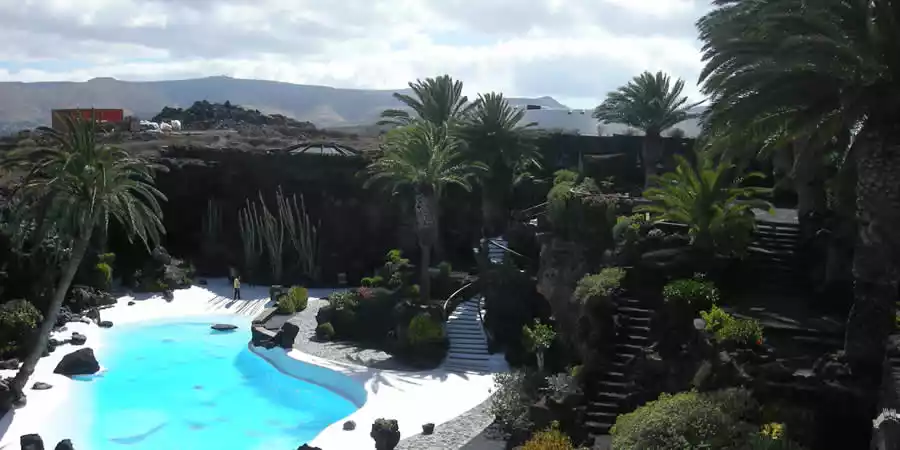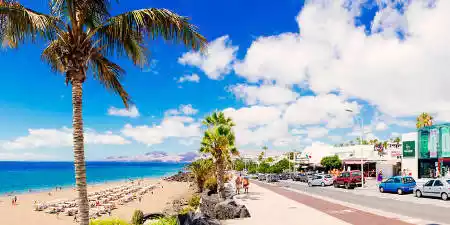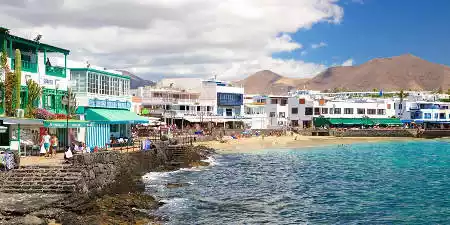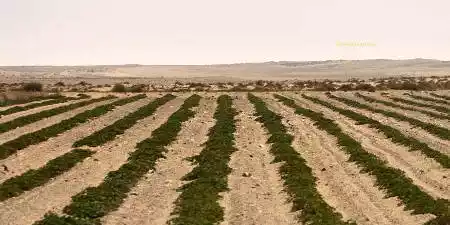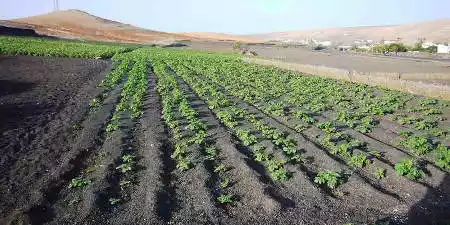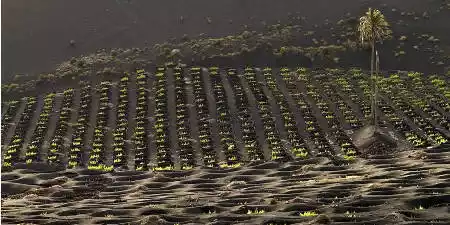Lanzarote's economy has evolved significantly in recent decades. Nowadays, to talk about the economy and tourism in Lanzarote is to do the same, since the island's economy is sustained almost exclusively by the income provided by tourism and the services that this activity promotes around it. Both tourism and services generate around 80% of economic activity and employment, which are concentrated in the tourist centers developed on the coasts of Tías (Puerto del Carmen), Teguise (Costa Teguise), and Yaiza (Playa Blanca), and in the capital of the island, Arrecife.
Costa Teguise - LanzaroteCosta Teguise is one of the main tourist centers on the island, and has a varied offer of accommodation, restaurants and...
Playa Blanca - LanzaroteThe great growth of Playa Blanca in recent years has consolidated it as an enclave ideal tourist destination in Lanzarot...
However, if we go back a bit to the past, the reality was quite different: the lack of raw materials and the aridity of the land caused long periods of poverty. Before tourism, agriculture, fishing, and livestock were the main sources of income. Despite this, these activities continue to play an important role in the local economy. The island has a large amount of land dedicated to the production of wine and crops such as sweet potatoes and onions, as well as small cattle farms dedicated to the production of milk and cheese. Fishing is mainly focused on catching fresh fish, both in nearby waters and offshore.
However, it is important to highlight that tourism is still the most important economic activity in Lanzarote, and is the main source of employment and wealth on the island. Visitors can find a wide range of accommodation options in Lanzarote, from luxury hotels to apartments and holiday homes. In addition, there is a wide variety of tourist activities available on the island, such as water sports, boat excursions, and visits to wineries and centers of art and culture. In summary, tourism and related activities are the fundamental pillars of Lanzarote's economy, although agriculture, livestock, and fishing continue to have their place in the local economy.
Designation of Origin Lanzarote
Until recently, the dominant economic activity in the vast majority of the municipalities of Lanzarote was agriculture and, to a lesser extent, fishing. However, tourism is currently the main source of resources.
The arrival of Tourism in the 1960s supposed a rapid transformation of the Island, with the extension of electrification, the installation of No desalination plants that ensure the water supply, etc.
Tourist centers were created in Puerto del Carmen and later in Costa Teguise and Playa Blanca, and recently Puerto Calero and simultaneously the Lanzarote artist César Manrique begins the design and construction of the Cabildo's network of Art, Culture and Tourism Centers, an example of the integration of human intervention in the island's landscape, and representative of an awareness of respect and care of the Nature of Lanzarote.
Lanzarote begins to grow, and the tourist sector attracts significant immigration from the rest of the State and the world. This multicultural population enjoys the development of infrastructures, care services and numerous cultural activities.
The development experienced by the island occurs in harmony with Nature, which makes the Island an example of sustainable development recognized by the UNESCO in 1993 with the declaration n of Biosphere Reserve. Lanzarote is also a pioneer in the Canary Islands in proposing new formulas for tourism development and planning, aimed at residents and visitors continuing to enjoy a territory of enormous beauty and uniqueness.
Since the maximum altitude of the island only reaches 670 m in Peñas del Chache, its entire surface is below the inversion level of the trade wind. This physical fact hinders the orographic rains that are so important in the other western Canary Islands since there is no mountainous obstacle that can stop the "sea of clouds". On the other hand, Lanzarote is, together with Fuerteventura, the closest island to the African continent. As a consequence, the average annual rainfall is very low and rainfall is irregular, not exceeding 47 days of rain per year.
On the other hand, much of the island is covered by recent volcanic materials, with eruptions dating from the 18th and 19th centuries. The result is that an important portion of the insular surface is covered with badlands and lapilli (volcanic ash). Also notable for their extension are the jables or calcareous sands of marine origin formed by the remains of shells and mollusks brought by the wind.
Faced with these adverse conditions, the insular ingenuity has been able to develop an entire culture of agriculture without water tremendously adverse conditions, but which has resulted in one of the most spectacular adaptation systems known.
As a result of this unique agricultural culture in Lanzarote, there are two own forms of cultivation due to the nature of the Agricultural soil referred to as jables, artificial enarenados, and natural enarenados.
In conclusion, agriculture in Lanzarote is exceptional due to adverse environmental conditions. The existence of important agriculture is due to the ingenuity of a man who has resolved the disadvantages of that situation. Cultivation in sandboxes and jables allow us to achieve yields per hectare similar to those obtained in irrigated land. This type of agriculture has meant a brake on the erosion of an arid environment, where the scarce existing resources have been optimized to develop quality agriculture and the creator of the landscape.
-
The manifest aridity of Lanzarote is wiped away with the use of jables, since these sands of organic origin conserve and condense humidity.
-
The enarenados are built on soils covered with lapilli (volcanic ash). Their purpose is to conserve subsoil moisture.
-
The crops that can host these enarenados they must have a deep root system that allows them to go through the layer of lapilli.
For centuries, fishing has been an essential activity on Lanzarote, providing food and sustenance for the island's inhabitants since prehistoric times. However, in recent decades, the fishing sector has suffered a rapid decline. In the early 1970s, fishing was essential to the island's economy, but today it has taken a very secondary place.
The occupation of Western Sahara by Morocco in 1975 meant the loss of the traditional fishing ground in which the powerful fishing fleet of the island fished. The sardine fleet was the most important on the island, providing almost a thousand jobs on land, with four canning factories and three fishmeal factories.
At present, Lanzarote has a small artisanal fleet that is mainly dedicated to the capture of sama, corvina, grouper, and poplar, together with the inshore fleet that captures local species such as the vieja, the horse mackerel, and the salema. During the migration season, tuna fishing is especially important. The catches obtained feed the restaurants of the coastal towns, where you can enjoy fresh fish at any time of the year.
Despite the decline of the fishing sector, sport, and tourist fishing is now a popular activity on Lanzarote. There are many places on the island where you can rent boats and fishing equipment to enjoy sea fishing.
SportfishingThere are more and more lovers of sport fishing, and especially of catching marlin.
Cattle farming in Lanzarote
Despite the aridity resulting from a long dry season and the fact that a large part of the island's surface is dry. Covered by lava that does not allow the growth of vegetation, Lanzarote has historically maintained an outstanding cabin in close relationship with the crops.
You can still see in the countryside of the island, around the rural houses, the well-known pajeros (stacks of cereal straw, legumes and, above all, sticks that the peasant concentrated in a certain place, giving it the shape of a frustum of a cone, with the upper part covered with earth). This type of storage made it possible to maintain an acceptable cabin between the stable and the stubble, especially for the more frugal species such as goats.
However, the crisis in peasant activity manifests itself with greater virulence in livestock because it requires greater dependence. If we analyze the evolution of the cattle herd in the last twenty years we can verify a drastic and progressive reduction of the cattle and sheep , relating this decrease to the crisis of cereal and legume crops, basic elements of the traditional model.
On the other hand, with cattle goats a surprising fact occurs. From 14,300 head in 1972, it fell progressively to 3,000 in 1988. However, we are currently experiencing a great recovery, with the current herd standing at around 15,000 head. This ascent will to be attributed to two important factors that have influenced the development of livestock on the island. In the first place, the appearance of a series of promotional campaigns, encouraging the farmer to recover the image and quality of the excellent rabbit cheese. Secondly, the implementation of business and union association initiatives that have been a guarantee for the continuity of livestock activity, whose production is currently around half a million kilos a year.
The current market for these cheese is distributed between 60% of internal consumption on the island and the rest is absorbed by the archipelago market, more specifically by the islands of Tenerife and Gran Canaria.
Cattle farming in Lanzarote
Interesting documentary divided into three parts about livestock in Lanzarote.
Construction and all its derivatives are also part of the industry of the island, fruit, albeit from that generated by tourism itself.
The electrical energy is obtained from the thermal generation system, with the exception of some solar installations, private wind wheels and two electric parks. licos, one with five mills in Montaña Mina and another with several dozen in the municipality of Haría.
Water has always been one of the main problems of the people of Lanzarote. Due to the scarcity of water and the vertiginous increase in the population of Lanzarote, the island is supplied with it thanks to the water treatment plants, in which seawater is desalinated by means of thermal energy.

